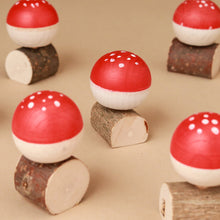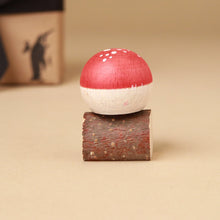Upside-Down Wooden Spinning Top | Toadstool Mushroom & Stand
This "Upside-Down" spinning top,often referred to as the Tippe Top, has a rather unique quality. It actually turns itself upside down and spins on its stem - all by itself! Originally patented back in 1891 by Helene Sperl of Germany, Danish engineer Werner Ostberg created his own version in 1950. His inspiration came from a visit to South America where he had seen locals playing with a small, round fruit. When they turned it by the stalk, much like an old-fashioned spinning top, it would spin for a second and the invert itself and spin on its stalk. The top is bipartite, clinch gudgeon glued, providing an inseparable bond of each component, painted and varnished and complies with European safety standards. You will also find the company's trademark burn line along its center.
Description
A modern spin on an ancient toy that provide endless hours of fascination. Handcrafted in limited quantities in Austria, these wooden spinning tops are a best seller. The tops are made from a variety of woods native to Europe and produced in unique color combinations. So beautifully balanced, they spin for minutes at a time. And, when finished spinning, each top is worthy of display in a glass case. A clever conversation piece, display a collection of these beautiful little works-of-art atop a mirror on your coffee or dining room table for your next dinner party, or display a few on top of your desk and use them as stress relievers throughout the day. Perfect for someone who has everything. They are ideal for birthday parties (kids and adults alike), gift bags and corporate gifts. Each top comes with its very own linen pouch.
This "Upside-Down" spinning top,often referred to as the Tippe Top, has a rather unique quality. It actually turns itself upside down and spins on its stem - all by itself! Originally patented back in 1891 by Helene Sperl of Germany, Danish engineer Werner Ostberg created his own version in 1950. His inspiration came from a visit to South America where he had seen locals playing with a small, round fruit. When they turned it by the stalk, much like an old-fashioned spinning top, it would spin for a second and the invert itself and spin on its stalk. The top is bipartite, clinch gudgeon glued, providing an inseparable bond of each component, painted and varnished and complies with European safety standards. You will also find the company's trademark burn line along its center.
Degree of Difficulty: Klaus rates this top a 3 out of 6 in terms of difficulty
Choking Hazard: not suitable for children under 3 years old.
More to the Story
The Mader family business, owned and operated by Klaus and Margit Mader, was founded in 1991 in Austria. The spinning top always played a major role in their woodworking shop. What began as a hobby to fill time, with a very special “thrown top” Klaus used to play with in his homeland as a child (called a TOTZ’N), transformed into a passion that occupied a significant amount of their time, as these toys can be somewhat addictive.
Mader creates all of their tops exclusively by hand. Classical wood turning techniques are used, as are more technically difficult methods, such as overhead reaming and undercutting. In up to 20 work stages, the tops are turned, burned, embossed, carved, brushed, painted and varnished.
Working by hand allows Mader to properly enhance and showcase the interesting and rare woods they so often use. The very bright, hard maple is best suited as the base of their painted tops while the rich variety of European woods produce the characteristic color spectrum that is typical of Mader tops. For the natural wood tops, their diverse color palette is achieved through the use of cherry, pear, birch, ash, walnut, plum, acacia, and Crown-of-Thorns woods. Their trademark remains the burned-in stripe on the equator of each top.
Mader’s business philosophy is quite simple. All tops are to be made by hand, suitable as toys for children of all ages, affordable and, even if already played with, can be displayed in a museum display case. We whole-heartedly agree.
History of Tops
The top is one of the oldest toys and, at the same time one of the oldest tools (used to make fire during the stone ages and spinning wool with distaffs). Used in all cultural circles of the world, tops were made from all imaginable materials nature had to offer: bones, clay, wood, stone, etc.
The unique characteristic that remains the same among all tops in all cultures is the innate instinct to convert the “pincer grip” into a turning movement in order to observe and maintain the effect of a rotating, turning body.
Interestingly, one finds historical tops in the various toy museums and toy collections of the world, which have survived for centuries, although they consist mainly of wood, a very transitory material. Thus these little objects were already very valuable to their possessors, otherwise they would not have survived this long.
A researcher of tops has the possibility to grapple with the various cultures (Gasing Url, Malaysia), religions (Hanukkah, Israel) and epochs (EDO/Japan) with the historical background of top games (Jesus as a child with a whip-spun top) and as the case may be, the physical regularities of tops (tippe top).
With all its facets, the top will therefore always find top fanciers.
Dimensions
This top measures 1.5" L x 1" diameter.
Safety & Care
- Choking Hazard: not suitable for children under 3 years old.
- This spinning top is suitable for ages 5 to adult.
- Made from ash and hardwoods.





































































































